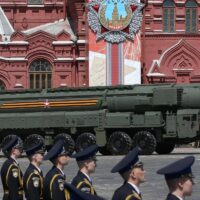England (Brussels Morning Newspaper) In the early 1970s, the government of the United Kingdom compiled a top-secret list of 106 locations around the nation that were considered “possible nuclear targets.” These locations included cities, villages, and military stations. In preparation for the possibility that Russia would launch a nuclear assault, let’s look at some of the potential nuclear targets in England.
List of Probable Nuclear Targets in England
During the time of the cold war, military leaders agreed on a list of locations they believed most likely to be targeted by a nuclear assault from the Soviet Union. While the vast majority of big cities were covered, there were glaring gaps in coverage. Cambridge was on the list of potential targets, but Oxford was not; Bristol was, but Brighton was not, and Edinburgh was, but Aberdeen was not.
On May 2, 1972, the list of “possible nuclear targets in the United Kingdom,” authorised by the Cabinet Office, was disseminated to defence commanders by Air Commodore Brian Stanbridge under cover of the “top secret” classification. According to what he stated, “It is not an exhaustive list of all targets likely to be targeted if global war breaks out.” It consisted of 37 air bases in the United Kingdom and the United States, 38 towns, cities, and government centres, 25 control, communications, and radar facilities, and six naval locations.
An estimate from the joint intelligence committee was cited in an annexe to his memo. According to this estimate, the Soviet Union could launch an initial nuclear strike against Britain with 150 land-based missiles and an unknown number of submarine-launched missiles. His memo was sent to the joint intelligence committee. It warned, “They are unlikely to be restrained by the concern of overkill.”
Potential Nuclear Attacks
According to the addendum, while estimating the potential for nuclear attacks by the Soviet Union, “identical planning assumptions to those which we would apply” were utilised. Because of this, the adversary’s goal would probably be to accomplish a minimum damage expectation of at least 50% with an assurance factor of 90% or higher.
It was anticipated that two to four bombs with a maximum yield of five megatons would detonate over London, causing widespread destruction. It was speculated that Glasgow, Birmingham, and Manchester would be hit by one or two “airbursts” containing up to five megatons. That makes it 333 times more powerful than the 15-kiloton nuclear weapon dropped by the United States on the city of Hiroshima in Japan in August of 1945, which was responsible for the deaths of 140,000 people.
Read More: What Are The Nuclear Targets in France?
Strategists’ Nuclear Targets in England
Military strategists have determined that some of Britain’s more isolated areas may be bombed. A three-megaton bomb was scheduled to detonate near a radar station currently used as a vacation resort on the Unst in Shetland island, the most northerly inhabited island in the United Kingdom.
Another location of interest was Orford Ness, located on the coast of Suffolk and was formerly a part of an experimental radar system in the United States known as Cobra Mist but is now a nature reserve. Nuclear airfields such as those located at Greenham Common in Berkshire and Machrihanish on the Mull of Kintyre were included on the list. Additionally, nuclear submarine bases located on Clyde near Glasgow were included.
According to other high-level memoranda from 1971, the target list was compiled for military preparation and to assist with “contingency planning notably in the realm of home defence.” The home defence included taking precautions to safeguard and aid citizens survive in the event of an attack, such as constructing bomb shelters.
However, according to the researcher who discovered the records, Brian Burnell, a former nuclear weapons design engineer, the true goal was not to safeguard civilian targets. According to what he stated, military strategists intended to ensure that nuclear bombers stationed in the UK survived so they could launch a counterattack against the Soviet Union.
Conclusion
According to historians, there were priority nuclear targets in England for the Soviet Union in the 1970s since it was the only state in western Europe that was a member of the military organization of Nato. 1966 was the year France finally gave up. They said: “There was no civil defence against a large-scale nuclear strike in a nation the size of Britain; the idea that there was such a defence was a lie. Whitehall was aware of this, as were most people in the country.



